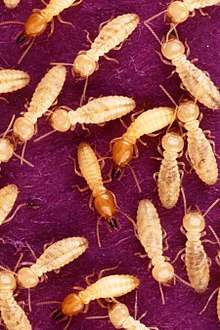Coptotermes
Coptotermes is a genus of termites in the family Rhinotermitidae. There are about seventy-one species, many of which are economically destructive pests. The genus is thought to have originated in southeastern Asia. Worker termites from this genus forage underground and move about in roofed tunnels that they build along the surface.[1]
| Coptotermes | |
|---|---|
 | |
| Formosan subterranean termites | |
| Scientific classification | |
| Kingdom: | Animalia |
| Phylum: | Arthropoda |
| Class: | Insecta |
| Order: | Blattodea |
| Infraorder: | Isoptera |
| Family: | Rhinotermitidae |
| Subfamily: | Coptotermitinae |
| Genus: | Coptotermes Wasmann 1896 |
| Species | |
| Synonyms | |
| |
In Australia, Coptotermes colonies sometimes host a parasitic species of termite, Ahamitermes. The host and the parasite dwell in separate parts of the mound nest and are mutually antagonistic. The Ahamitermes live in the innermost parts of the nest and feed on the "carton" material with which the galleries are lined which consists of soil particles, chewed wood and cellulose, bound together with saliva and faeces. They are thus dependent on their host for both their food and their home and are not found in any other situations.[2]
Species
This is an incomplete list of species:
- Coptotermes acinaciformis
- Coptotermes brunneus
- Coptotermes ceylonicus
- Coptotermes curvignathis Holmgren
- Coptotermes elisae
- Coptotermes emersoni
- Coptotermes formosanus - Formosan subterranean termite
- Coptotermes frenchi
- Coptotermes gaurii
- Coptotermes gestroi - Asian subterranean termite
- Coptotermes havilandi
- Coptotermes heimi
- Coptotermes kalshoveni
- Coptotermes lacteus
- Coptotermes parvulus Holmgren
References
- Gentz, Margaret C.; Rubinoff, Daniel; Grace, J. Kenneth (2008). "Phylogenetic Analysis of Subterranean Termites (Coptotermes spp., Isoptera: Rhinotermitidae) Indicates the Origins of Hawaiian and North American Invasions: Potential Implications for Invasion Biology" (PDF). Proceedings of the Hawaiian Entomological Society. 40: 1–9.
- Calaby, J. H. (1956). "The distribution and biology of the genus Ahamitermes (Isoptera)". Australian Journal of Zoology. 4 (2): 11–124. doi:10.1071/ZO9560111.